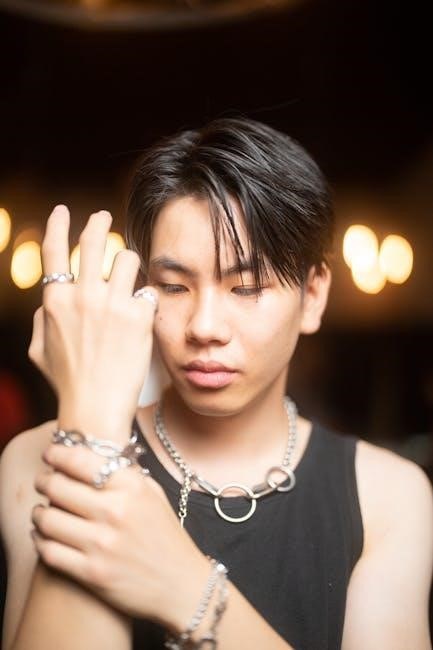Creating a list of masculine and feminine words in French is essential for mastering gender rules. This PDF document provides a clear guide‚ including common professions‚ suffixes‚ and exceptions. It helps learners practice and understand the difference between masculine and feminine nouns‚ making it easier to use the correct articles and adjectives in sentences. Organizing words by gender and updating the list regularly ensures effective learning and long-term retention of French grammar rules.

Understanding the Basics of Masculine and Feminine Nouns
Mastering the distinction between masculine and féminine nouns is fundamental in French. Nouns are categorized into two genders‚ and this classification affects articles‚ adjectives‚ and pronouns. For example‚ le (masculine) and la (feminine) are used to specify nouns. Many nouns follow patterns‚ such as endings like -e‚ -ie‚ or -elle‚ which often indicate feminine nouns‚ while endings like -age‚ -ment‚ or -isme typically denote masculine nouns. However‚ exceptions exist‚ and memorization is key. Creating a list of masculine and feminine words helps learners track and internalize these rules. Regularly updating this list with new vocabulary ensures consistent progress in understanding and applying French gender rules effectively.
Why Learning Genders is Essential for French Mastery
Mastering the genders of French nouns is crucial for effective communication. The distinction between masculine and féminine nouns determines the form of articles‚ adjectives‚ and pronouns. For example‚ le (masculine) and la (feminine) must be used correctly. Incorrect gender usage can lead to misunderstandings‚ as it alters the meaning of sentences. A list of masculine and feminine words helps learners recognize patterns‚ such as endings like -eau (often masculine) or -elle (often feminine). This knowledge is vital for constructing grammatically correct sentences and for understanding spoken and written French. Regular practice with such lists ensures learners can apply gender rules instinctively‚ enhancing their overall proficiency in the language.

Rules for Determining the Gender of Nouns
Determining noun gender in French often relies on endings. Masculine nouns frequently end in -eur or -age‚ while feminine nouns often end in -elle or -esse. Specific suffixes indicate gender‚ aiding learners in categorization and proper article usage.

Using Definite Articles (Le‚ La‚ Les)
In French‚ definite articles (le‚ la‚ les) indicate the gender and plurality of nouns. Le is used for masculine singular nouns‚ while la is for feminine singular nouns. Les applies to plural nouns of both genders. For example‚ le livre (the book‚ masculine) and la maison (the house‚ feminine). Plural forms are les livres (the books) and les maisons (the houses). The article must match the noun’s gender and number. This rule applies universally‚ except for nouns starting with a vowel sound‚ where l’ is used‚ e.g.‚ l’eau (the water). Mastering these articles is crucial for accurate French expression‚ as they reflect the noun’s gender and plurality clearly.
Identifying Suffixes That Indicate Gender
In French‚ certain suffixes often indicate the gender of nouns. Masculine nouns frequently end with suffixes like -age (e.g.‚ le village)‚ -eur (e.g.‚ le photocopieur)‚ or -isme (e.g.‚ le tourisme). Feminine nouns often end with -e (e.g.‚ la plage)‚ -ie (e.g.‚ la folie)‚ or -tion (e.g.‚ la television). Additionally‚ suffixes like -esse (e.g.‚ la tendresse) and -ure (e.g.‚ la voiture) are typically feminine. While these patterns are helpful‚ exceptions exist‚ such as le merci (masculine) or la fin (feminine). Recognizing these suffixes aids in determining gender‚ though memorization is still necessary for many nouns.

Common Masculine and Feminine Word Endings
Masculine nouns often end with -age‚ -eur‚ or -isme‚ while feminine nouns frequently end with -e‚ -ie‚ or -tion. These suffixes help identify gender in French‚ though exceptions exist.
Masculine Nouns: Typical Suffixes
Masculine nouns in French often end with specific suffixes that help identify their gender. Common masculine endings include -age (e.g.‚ le village)‚ -eur (e;g.‚ le jardin)‚ and -isme (e.g.‚ le tourisme). Additionally‚ many masculine nouns end with -ment‚ such as le paiement‚ or -oir‚ like le miroir. Words ending in -al or -el are also typically masculine‚ such as le cheval or le tunnel. Recognizing these patterns is crucial for determining gender and using the correct articles (le‚ un) and adjectives. While these suffixes are helpful‚ exceptions exist‚ so memorization and practice are essential for mastery. Creating a list of words with their suffixes can aid in learning these patterns effectively.
Feminine Nouns: Typical Suffixes
Feminine nouns in French often end with specific suffixes that signal their gender. Common feminine endings include -ée (e.g.‚ la purée)‚ -esse (e.g.‚ la gentillesse)‚ and -ette (e.g.‚ la fillette); Additionally‚ many feminine nouns end with -ine (e.g.‚ la marine) or -ure (e.g.‚ la chaussure). Words ending in -tion or -sion are also typically feminine‚ such as la télévision or la discussion. While these patterns are helpful‚ exceptions exist‚ so memorization is key. Creating a list of words with their suffixes can aid in recognizing these patterns and improving gender accuracy in French. Regular practice and review are essential for mastering these rules effectively.

Exceptions to Gender Rules
Nouns That Do Not Change Between Masculine and Feminine
Certain French nouns remain identical in their masculine and feminine forms‚ such as un prince (male prince) and une princesse (female princess). These exceptions require careful attention to context or additional modifiers to clarify gender‚ as their endings do not change‚ unlike typical masculine or feminine nouns.
Some French nouns remain identical in masculine and feminine forms‚ such as un maître (male teacher) and une maîtresse (female teacher). These exceptions do not change their endings‚ making them tricky for learners. For example‚ un prince (male prince) and une princesse (female princess) retain the same root word but require context or additional modifiers to clarify gender. Similarly‚ un homme (man) and une femme (woman) are distinct‚ while un garçon (boy) and une fille (girl) follow typical patterns. These exceptions highlight the importance of memorization and understanding context in French grammar.
Words That Have Different Meanings in Masculine and Feminine Forms
Some French words change meaning entirely when their gender changes. For example‚ le livre means “the book‚” while la livre refers to “the pound” (a unit of weight). Similarly‚ un bassin (masculine) means “a basin” or “a pool‚” whereas une bassine (feminine) means “a small bowl.” These differences highlight the importance of understanding gender-specific meanings. Other examples include un mode (masculine for “fashion”) and une mode (feminine‚ also “fashion‚” but with different usage). Such pairs emphasize the need to learn each word’s gender and meaning separately‚ as they can completely alter the sense of a sentence. This complexity makes mastering French genders both challenging and fascinating.
Importance of Gender in French Grammar
French gender rules are crucial for correct article and adjective usage. Understanding masculine and feminine forms ensures proper noun-pronoun agreement and accurate sentence structure. A list of words helps learners master these distinctions effectively.
Agreement with Adjectives and Pronouns

French adjectives and pronouns must agree with the gender and number of the nouns they describe. For example‚ le (masculine) and la (feminine) articles determine the form of adjectives like grand (masculine) and grande (feminine). Similarly‚ pronouns such as il (he) and elle (she) depend on the noun’s gender. Understanding gender rules is vital for accurate sentence structure. A list of masculine and feminine words helps learners track and apply these agreements correctly. Regular practice with such lists ensures mastery of adjective and pronoun usage‚ enhancing overall French language proficiency.
Impact on Verb Conjugation in Certain Cases

In French‚ verb conjugation is primarily based on tense‚ mood‚ and the subject pronoun. However‚ gender plays a role in specific cases‚ particularly with past participles. For example‚ when using être or avoir in compound tenses like the passé composé‚ the past participle must agree with the subject’s gender. For instance‚ elle a chantée (she sang) vs. il a chanté (he sang). This agreement is essential for proper grammar. A list of masculine and feminine words helps learners identify the correct gender‚ ensuring accurate verb conjugation. Regular practice with such lists enhances mastery of French verb usage‚ especially in complex sentence structures where gender agreement is critical.
Practical Exercises for Learning Genders
Engage with matching games to pair masculine and feminine nouns. Practice filling in the blanks with correct articles. Use flashcards to memorize gender rules and create a personalized word list for tracking progress.

Matching Games for Masculine and Feminine Nouns
Interactive matching games are an engaging way to learn French noun genders. These activities involve pairing masculine and feminine forms of words‚ such as un ami with une amie. By dragging and dropping or selecting from options‚ learners can practice recognizing gender patterns. Many online tools and PDF resources offer these exercises‚ often organized by themes like professions or everyday objects. For example‚ matching le professeur with la professeure helps reinforce gender associations. Such games also include visual aids‚ like images or color-coded columns‚ to make learning more intuitive. Regular practice with these exercises improves memory retention and enhances the ability to use correct articles and adjectives in sentences. They are particularly effective for beginners building their vocabulary and understanding of gender rules.
Filling in the Correct Article (Le‚ La‚ or Les)
Filling in the correct article (le‚ la‚ or les) is a fundamental exercise for mastering French gender rules. Many PDF resources provide blank spaces next to nouns‚ requiring learners to write the appropriate article based on the word’s gender. For example‚ learners might see “_____ chaise” and write “la” since chaise is feminine. These exercises often include lists of words organized by theme‚ such as professions or household items‚ making practice focused and effective. Interactive tools also offer drag-and-drop or multiple-choice activities to test article usage. Recognizing patterns‚ like masculine nouns ending in -eur or feminine nouns ending in -esse‚ helps learners make informed choices. Regular practice with these exercises improves accuracy and reinforces the connection between nouns and their corresponding articles in French sentences.

Creating a Personalized List of Masculine and Feminine Words
Start by compiling a list of common French nouns‚ noting their gender. Organize words by themes (e.g.‚ professions‚ food) and include their endings to identify patterns. Regularly update your list with new words encountered in readings or conversations to build a robust reference for mastering French gender rules.
How to Organize Your List for Effective Learning
Organize your list of masculine and feminine words into clear categories‚ such as professions‚ food‚ or common nouns. Use tables or charts to separate masculine and feminine words‚ making it easier to compare and review. Include examples of words with specific endings‚ like -eur for masculine or -esse for feminine‚ to help identify patterns. Group similar words together‚ such as le journal (masculine) and la revue (feminine)‚ to highlight gender distinctions. This method allows you to focus on high-frequency words and gradually expand your vocabulary. Regularly reviewing and updating your list ensures consistent learning and mastery of French gender rules.
Updating Your List as You Progress in French
Regularly updating your list of masculine and feminine words is crucial for consistent learning. As you encounter new vocabulary through reading‚ conversations‚ or media‚ add the words to your list‚ noting their gender. Review and organize the list periodically to reinforce memory. Use colors or notes to highlight tricky words or exceptions. Keep separate sections for words with similar endings‚ such as -eur (masculine) or -esse (feminine)‚ to identify patterns. Updating your list ensures it remains relevant and tailored to your progress. Over time‚ this practice helps solidify your understanding of French gender rules and improves your ability to use the correct articles and adjectives in context.
Maintaining a list of masculine and feminine words is vital for mastering French gender rules. Regular updates and organized learning ensure effective language acquisition and long-term retention of grammar concepts.
Final Tips for Mastering Masculine and Feminine Genders
To effectively master French gender rules‚ create a personalized list of masculine and feminine words‚ updating it regularly as you learn. Focus on recognizing suffixes like -eur (masculine) or -ette (feminine) to identify genders quickly. Practice with exercises such as matching games or filling in articles‚ and use mnemonics to remember tricky cases. Flashcards and mobile apps can also help reinforce learning. Regularly review and test yourself to ensure long-term retention. Finally‚ immerse yourself in the language by reading and listening to French content‚ noting gender usage in context. Consistent practice and exposure are key to mastering masculine and feminine genders in French.
Resources for Further Practice and Learning
For further practice‚ download a PDF guide that lists masculine and feminine words‚ along with exercises to test your understanding. Websites like vivelefle.jimdofree.com offer detailed lessons and printable worksheets. Use interactive tools such as matching games and quizzes to reinforce learning. Flashcard apps like Anki or Quizlet can help you memorize words and their genders. Additionally‚ language learning apps like Duolingo and Babbel provide structured lessons on French gender rules. Practice regularly by identifying genders in French texts or movies‚ and consult dictionaries for unclear cases. Finally‚ join online forums or language groups to discuss challenges and share tips with fellow learners. Regular practice and exposure are key to mastering masculine and feminine genders in French.
